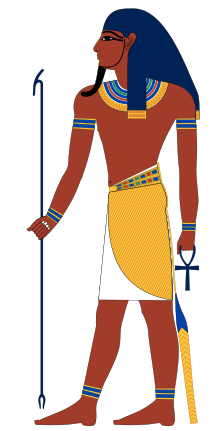Saosis
| Atum | ||||
|---|---|---|---|---|
| God of creation | ||||

Atum, finisher of the world
|
||||
| Name in hieroglyphs |
|
|||
| Major cult center | Heliopolis | |||
| Personal Information | ||||
| Consort | Iusaas | |||
| Children | Shu and Tefnut | |||
| Parents | Nu | |||
Atum (/ɑ.tum/), sometimes rendered as Atem or Tem, is an important deity in Egyptian mythology.
Atum's name is thought to be derived from the word tem which means to complete or finish. Thus he has been interpreted as being the 'complete one' and also the finisher of the world, which he returns to watery chaos at the end of the creative cycle. As creator he was seen as the underlying substance of the world, the deities and all things being made of his flesh or alternatively being his ka.
Atum is one of the most important and frequently mentioned deities from earliest times, as evidenced by his prominence in the Pyramid Texts, where he is portrayed as both a creator and father to the king.
In the Heliopolitan creation myth, Atum was considered to be the first god, having created himself, sitting on a mound (benben) (or identified with the mound itself), from the primordial waters (Nu). Early myths state that Atum created the god Shu and goddess Tefnut by spitting them out of his mouth. To explain how Atum did this, the myth uses the metaphor of masturbation, with the hand he used in this act representing the female principle inherent within him. Other interpretations state that he has made union with his shadow.
In the Old Kingdom the Egyptians believed that Atum lifted the dead king's soul from his pyramid to the starry heavens. He was also a solar deity, associated with the primary sun god Ra. Atum was linked specifically with the evening sun, while Ra or the closely linked god Khepri were connected with the sun at morning and midday.
...
Wikipedia
